King's Cup - 1937
-
Percival, Capt Edgar Wikner
Capt Edgar Wikner Percival 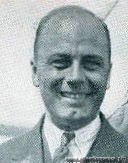 1930, aged 32
1930, aged 32Australian aeronautical genius who ended up in the USA and New Zealand, via Luton.
b. 23 Feb 1897 in Albury, N.S.W. In 1915, while training in England, he became only the third person on record to recover from a spin (supposedly, Fred Raynham [q.v.] was the first). He later wrote: "After that I found that spinning was great fun and spun a Bristol Scout the next day. Very much later, on the Western Front, I found a spin was a very speedy way of dropping on the enemy - especially through a handy cloud."
Designer, and pilot, of some of the finest racing and record-breaking aeroplanes of all time.
"He always flies his rakish Mew Gulls in a soft felt hat and tries to look as much unlike an intrepid birdman as possible, though he has never yet deceived the handicappers by this ruse."
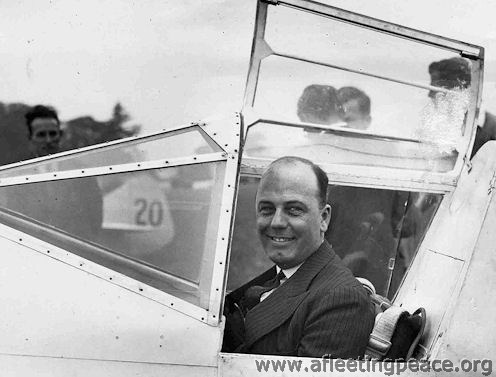 King's Cup 1934; sans trilby, for once
King's Cup 1934; sans trilby, for onceFlight said he "has an uncanny navigational sense in thick weather, but sometimes flies pensively past his destination in 100-mile visibility".
Michael Madigan wrote: "It was very difficult to resist his puckish humour and not to fall under his spell... In his early flying days he had a fox-terrier called Ginger Mick. This dog always sat in the [open] rear cockpit tethered to a spar. One day as Edgar was preparing to land he went into a loop to lose height, forgetting about his passenger. After levelling off he heard strange scrabbling noises from the back and looking out saw Ginger Mick frantically dog-paddling in the air suspended by his lead. Edgar managed to manoevre Ginger back into the plane, and after landing he thought he would never see Ginger Mick again as he rushed off, but Ginger was as persistent an aviator as his master and reappeared, to settle in his place at start-up, large as life, and eager for more."
 In 1956, with the EP.9 'Prospector'. And trilby.
In 1956, with the EP.9 'Prospector'. And trilby.© The Royal Aero Club
d. 21 Jan 1984; his ashes were taken by the RAAF "to be scattered in the very field in Richmond, N.S.,W., where it all began."
"Edgar Percival had a strong character, a high mental and moral sense, and was a perfectionist - the qualities which made him successful. He was the dominant presence which compelled attention in a group. This dominance arose from his vast knowledge of aviation in all its aspects... all this and his strength of will did not make him an easy associate. He could see problems clearly, had the energy to solve them, and drove himself relentlessly, which made him rather intolerant of those less gifted."
(All quotes via Martin Barraclough, for which many thanks)
-
Piper, Harold Lord
Mr Harold Lord 'Pip' Piper 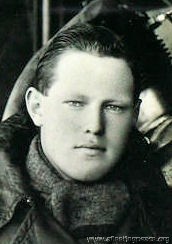
photo: 1918, aged 20
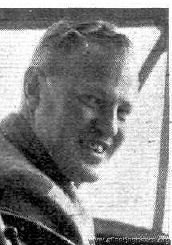
photo: 1937, aged 39
Originally from New Zealand, a farmer.
He and Cyril Kay flew a Desoutter from England to Australia in 1930; later chief test pilot for Shorts, until 1948.
"Apart from flying, Pip's other passions in life are duck shooting, guns and boats."
![Lankester Parker and Harold Piper [0122-0101]](/images/gallery/aviators/preview/333s333/Lankester%20Parker%20and%20Harold%20Piper%20%5B0122-0101%5D.jpg) (r), with Lankester Parker. © The Royal Aero Club
(r), with Lankester Parker. © The Royal Aero Clubd. 1965
-
Rose, Thomas
Flt-Lt Thomas 'Tommy' Rose DFC 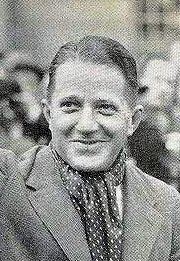 1936
1936b. 27 Jan 1895 - Alton, Hants
One of the best-known racing and pioneering pilots of the 30s.
His father, John, was a farm bailiff at Basing Farm, Froxfield, nr Petersfield, Hants. After working briefly as a bank clerk, Tommy joined the Royal Navy in 1914 and then transferred to the R.F.C. in June 1917.
"He was shot down three times, but escaped each time. He was awarded the DFC for his work with the fighter squadron in which Billy Bishop, VC, served. "
m. 1925 Margaret Elizabeth [Ashford], [divorced 1938]
Retired from the RAF in 1926 with the rank of Flight-Lieutenant.
In December 1931, he made an unsuccessful attempt on the UK-Cape record, and then flew back "by easy stages".
From Oct 1933, Manager and Chief Instructor at Sywell.
"TOMMY ROSE is gone from Sywell, but not forgotten. As sales manager for Messrs. Phillips and Powis, the Reading aircraft manufacturers, he spends quite a lot of time flying round the country. Last week his photograph was 'splashed' in all the national daily papers, greeting Mr. H. L. Brook, the Yorkshireman airman, on his arrival at Croydon after breaking the Australia-England record previously held by Jim Mollison. There was no mistaking Tommy’s famous sports jacket and boyish grin!
Mr. Rose, the way, left a last impression at Sywell. Shortly before leaving, when the new gate was being erected in front of the clubhouse, he carefully placed his foot in the wet cement and printed beside it 'Tom Rose' with a trowel. The cement hardened, and the 'Rose' mark is there for posterity to reverence! Hundreds of feet have since trod the hallowed spot." - Northampton Mercury, 12 April 1935
Competed in the King's Cup six times, winning it in 1935...
![Kings Cup 1938 Tommy Rose [0122-0170]](/images/gallery/air%20races/preview/333s333/Kings%20Cup%201938%20Tommy%20Rose%20%5B0122-0170%5D.jpg)
© The Royal Aero Club [0122-0170]
... and coming second in 1934 and 1936.
[The 1935 King's Cup itself recently sold at auction for £3,900:

Photo kindly supplied by Sarah Chambers, reproduced by kind permission of Sworders Fine Art Auctioneers.]
He became a national hero in March 1936 after his flight to Cape Town and back; "he can now claim to have made the fastest time for the trip both out and home. His new record is 6 days 6 hr. 57 min. (he got to the Cape in 89 hr. 37 min.), which beats F/O David Llewellyn's time—the previous best—by 5 hr. 6 min."
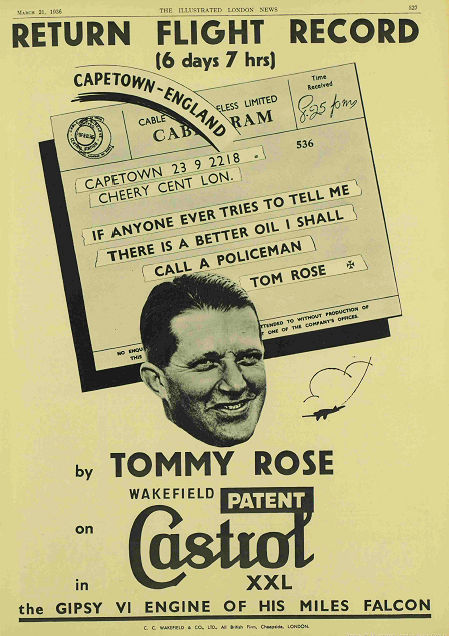
After the flight to the Cape, he had tea with the Prime Minister, General Hcrtzog, and also saw General Smuts. However, he was charmingly modest about his achievements:
"TOMMY ROSE ON LONG FLIGHTS
SAYS RECORD ATTEMPTS ARE 'LARGELY BUNKUM'
This flight business is bunkum! The authority for that picturesquely phrased piece of information is Flight- Lieutenant Tommy Rose, and he should know, for he hit the headlines in all the national newspapers when he smashed all records for the flight from London to the Cape. In a talk to the Round Table at Stewart's Cafe on Monday he summed up the whole business in these few words: 'All long distance flights are largely bunkum. The national newspapers, if there is no other news at the time, whip up an interest in these flights, and if one gets there safely and breaks a record everyone thinks: 'By gad, here's one of the twelve apostles come to life!’ (Laughter.)
'But I assure you there is nothing in it. The only things you have got do to be successful are to get the best machine you can find and then practise sitting still for a long, long time . . . . '
Reflections wise and witty on flying in general and his own flight in particular made Flight-Lieutenant Rose's talk one of the most delightful and amusing to which Tablers have listened to for a long time. His racy manner produced a laugh at almost every sentence, and a more unassuming world record breaker than this genial young man would be difficult to find.
There was one richly humorous story which is worth repeating. 'When I eventually got to the Cape I had to broadcast to the Union,' he said. 'The announcer seemed very nervous and this was what he said: ’Who do you think I have here the studio? None other than Mr Tom Mollison, who flew from London to the Cape in 37 days 18 hours.’ I met General Hertzog few days later and he said: 'if it takes all that time to fly, don't you think you had better come by boat next time?’
Flight-Lieutenant Rose answered a number of questions and urged the need for municipalities laying down landing grounds for aircraft. Members of the Rotary Club and of other Round Tables were present, as guests, to hear the airman’s talk. " - Eastbourne Gazette, 6 May 1936
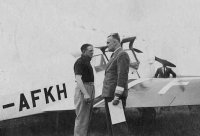
© The Royal Aero Club [0129-0039]
Before the 1936 Schlesinger Race to Johannesburg, he predicted: "It is my opinion that the pilot of the aeroplane which gets there in under forty-eight hours will deserve just about the biggest bunch of bananas ever found.
Having got lost myself many times down this route when flying without wireless, I fully expect to do so again, and the pilot in this race who can honestly say at the end that he was sure of his position all the time will either be very lucky, very clever, or have a queer idea of honesty."
From 1939 to 1946, Chief Test Pilot for Miles Aircraft, living in Sonning, Berks; in July 1943 he was reported to have "improved considerably and to be well on the way to recovery, after he contracted a chill when captaining his works cricket team. "
Won the Manx Air Derby in 1947, still flying a Miles Hawk; three circuits of the island at 181 mph.
d. 20 Jun 1968 - Alderney, Channel Islands.
-
Schreiber, Derek Shuldham
Mr Derek Shuldham Schreiber 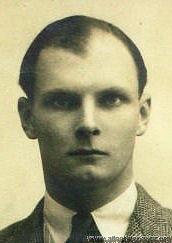 1929, when an Army officer (11th Hussars), aged 25
1929, when an Army officer (11th Hussars), aged 25'From Suffolk. Enjoys polo, hunting, shooting and other sports'.
Later a Brigadier:
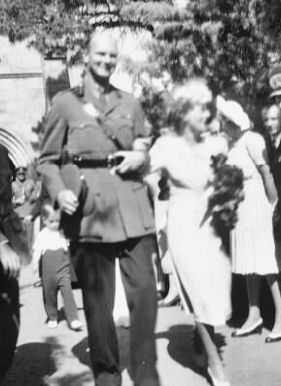
Brigadier Derek Schreiber, Chief of Staff to the Governor General and Viscountess Clive, Lady in Waiting to the Duchess of Gloucester leaving St. John's Church after their wedding, Canberra, 24 October 1945 - Trove
d. 1972 and is buried in Marlesford, Suffolk.
-
Stack, Thomas Neville
Capt Thomas Neville Stack 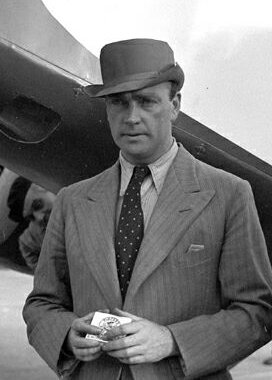 1934, aged 38
1934, aged 38
RAeC [0312-0087]
b. 1 April 1896; universally known as 'Stacko'
RFC in WWI, then became a familiar figure in aviation circles during the 1920s - in 1926 he and Bernard Leete made the first flight from England to India in two DH. Moths, one of several record-breaking flights.
He and J R Chaplin tried to fly to Australia and back in 1931, but had to turn back at Constantinople, Turkey, with carburettor trouble; later in the year the same pair attempted a flight to India and back, but again turned back with mechanical problems.
He was appointed 'Air Superintendent' of Iraq Airwork Ltd in 1933, and flew their first machine (a Spartan Cruiser) there via Cairo in 1933. Shortly afterwards, he flew 2 doctors and a nurse out to India, to perform an urgent operation on a Nepalese princess.
Late 1933 found him testing the Airspeed Courier - which is probably where he met Sydney Turner - and was widely expected to fly it in the MacRobertson Race. A month before the race, he broke (his own) London-Copenhagen record in a Miles Hawk, which is perhaps why he was too busy to inspect the Viceroy properly....
He turned up for the MacRobertson Race looking very tired and drawn - Alan Goodfellow described him as looking 'over-trained, physically', and Neville Shute Norway said he was "an exhausted and a worried man".
Shortly after the race, he was appointed Air Superintendent and Manager of Hillman's Airways; after that became part of British Airways he spent time in Turkey, advising them on civil aviation.
He was killed when run over by a lorry in Karachi, India on 22nd February 1949, aged 52. At first, the Karachi Police said he had committed suicide but, while agreeing that he was 'on the verge of a nervous breakdown', the inquiry decided that the cause of death was actually an aneurism of the aorta, and he would have died anyway.
Neville was "always very good company. He was never happier than when singing a song and strumming on his banjo."
-
Stent, Frederick William
Wing-Cmdr Frederick William Stent 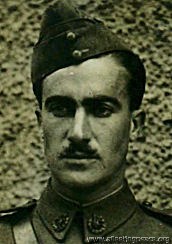 ' 1915, when a 2nd Lieutenant, RAC, aged 25
' 1915, when a 2nd Lieutenant, RAC, aged 25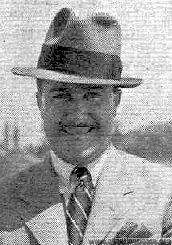 September 1937, aged 47
September 1937, aged 47A retired RAF officer'.
d. 28 Jun 1938 in the Miles M.11C (G-AEYI) which crashed at Harefield, Berkshire.
-
Waight, Robert John
Mr Robert John 'Bob' Waight 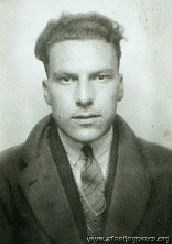 1932, aged 23
1932, aged 23Joined de Havilland at Hatfield in 1928 and was their chief test pilot from 1935; killed flying the TK4 at Hatfield in October 1937.
Hatfield later turned into an industrial estate (sigh) and Waight Close is named after him.
-
Waller, Kenneth Herbert Fraser
Mr Kenneth Herbert Fraser 'Ken' Waller 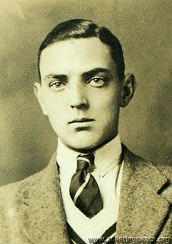 1930, aged 22
1930, aged 22
b. 7 April 1908, in Lambeth, London
As you can see, he was over 6ft 4in in height. Despite this, learnt to fly in Kent, got his aviator's certificate in 1930 and then became an instructor at Brooklands in Surrey.
Pilot, with Owen Cathcart Jones, of one of the D.H. Comets for the MacRobertson Race in 1934; given third prize (erroneously, in my view, but it's probably a bit late to say that now).
In 1935, got annoyed with Owen Cathcart Jones for something he said in his book that Ken felt "reflected on his courage and ability as a pilot", and even went to court over it. Owen replied that "that was the last thing he intended, as Mr. Waller and he had been, and still were, very good friends", which seemed to settle the matter.
He and Max Findlay competed in the Schlesinger Race to South Africa in 1936, in an Airspeed Envoy (No 13), but this crashed on take-off in Northern Rhodesia, killing Findlay and the radio operator; Ken was thrown out through a hole in the fuselage and badly hurt.
After WWII, became Miles Aircraft's chief test pilot (he delivered a Hillman Minx car to Orkney in 1948 at a cost of £35, you may remember).
-
Willis, Charles Henry
Mr Charles Henry Willis 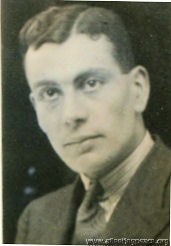 1933, when a bank clerk, aged 24
1933, when a bank clerk, aged 24'Assistant instructor to the Insurance Flying Club'
Page 2 of 2

